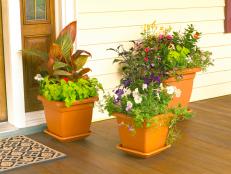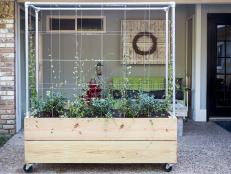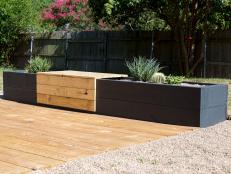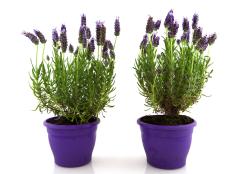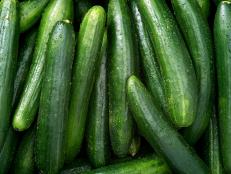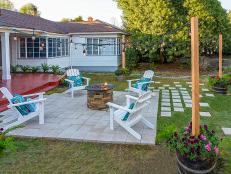How to Make a Vertical Garden With PVC Pipe
Plant a small-space vertical garden using PVC pipe.

Tomas Espinoza/Flynnside Out Productions
Materials and Tools
- plants with shallow roots
- 20" cube planter
- 4" diameter PVC pipe, 5' long
- 3/4" diameter PVC pipe, 5' long
- (2) 3/4" PVC end caps
- black zip ties
- weed cloth
- gravel
- potting soil
- mulch
- garden hose
- hacksaw
- silver marker
- measuring tape
- pencil
- (2) 12" bar clamps
- drill
- 3/16" drill bit
- metal sanding file
- utility knife
- gardening gloves
- garden trowel
- watering can
Measure and Cut PVC Pipes
Secure both PVC pipes to your work surface with bar clamps, and cut both to size using a hacksaw or reciprocating saw.

Tomas Espinoza/Flynnside Out Productions
Cut Holes for Plants
With the 4-inch PVC pipe still secure on the workbench, mark planting holes with a white or silver marker, keeping them about 6-8 inches apart. Punch out the holes with a drill and a 1-3/4-inch hole saw bit.

Tomas Espinoza/Flynnside Out Productions
Smooth Out Holes
Smooth all the rough edges using a metal file. Wipe away any excess dust or shavings.

Tomas Espinoza/Flynnside Out Productions
Add Drainage Holes
To prep the irrigation pipe, use a 3/16-inch drill bit to bore holes throughout the 3/4-inch PVC pipe.

Tomas Espinoza/Flynnside Out Productions
Add Weed Block
Wrap the 3/4-inch pipe with weed block material, and secure in place with zip ties. Secure PVC caps on both ends of the pipe.

Tomas Espinoza/Flynnside Out Productions
Put Irrigation Line in Place
Place the large pipe in the center of the planter, and slip the irrigation pipe inside the large one. Keep the 3/4-inch pipe centered, and add about six inches of gravel to anchor it.

Tomas Espinoza/Flynnside Out Productions
Secure Large Pipe
Place the 4-inch pipe in the center of the planter, and fill planter halfway with stones or gravel to aid in drainage. Keep in mind you’ll want at least 12 inches of the pipe under soil inside the planter, so it’s not too top heavy once filled with mature plants.

Tomas Espinoza/Flynnside Out Productions
Image 1

Tomas Espinoza/Flynnside Out Productions
Image 2
Add Potting Soil
Add potting soil into the top of the 4-inch pipe, keeping the irrigation line centered and capped as you scoop soil into the larger pipe. Don't worry about soil spilling out into the sides and base of the planter (Image 1). Continue filling until the planter and pipe have adequate soil (Image 2). Top the soil at base of the planter with mulch to keep moisture in.

Tomas Espinoza/Flynnside Out Productions
Image 1

Tomas Espinoza/Flynnside Out Productions
Image 2
Add Plants
Gently tuck small starter plants into the holes. Choose one type of plant for a uniform look, or mix it up for a more natural vibe. We used begonias, ivy, geraniums and pansies for a variety of colors and textures.

Tomas Espinoza/Flynnside Out Productions
Water Plants
To water plants, unscrew the cap off the irrigation pipe, and add water (Image 1). Fill to capacity, and replace the cap (Image 2).

Tomas Espinoza/Flynnside Out Productions
Image 1

Tomas Espinoza/Flynnside Out Productions
Image 2

Tomas Espinoza/Flynnside Out Productions









